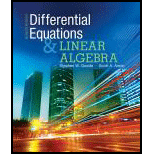
Consider the linear transformation
(a) Show that
(b) Find
Want to see the full answer?
Check out a sample textbook solution
Chapter 6 Solutions
Differential Equations and Linear Algebra (4th Edition)
Additional Math Textbook Solutions
Pathways To Math Literacy (looseleaf)
Elementary & Intermediate Algebra
Elementary Statistics
Calculus: Early Transcendentals (2nd Edition)
Introductory Statistics
College Algebra (Collegiate Math)
 Elementary Linear Algebra (MindTap Course List)AlgebraISBN:9781305658004Author:Ron LarsonPublisher:Cengage Learning
Elementary Linear Algebra (MindTap Course List)AlgebraISBN:9781305658004Author:Ron LarsonPublisher:Cengage Learning Linear Algebra: A Modern IntroductionAlgebraISBN:9781285463247Author:David PoolePublisher:Cengage LearningAlgebra & Trigonometry with Analytic GeometryAlgebraISBN:9781133382119Author:SwokowskiPublisher:Cengage
Linear Algebra: A Modern IntroductionAlgebraISBN:9781285463247Author:David PoolePublisher:Cengage LearningAlgebra & Trigonometry with Analytic GeometryAlgebraISBN:9781133382119Author:SwokowskiPublisher:Cengage


